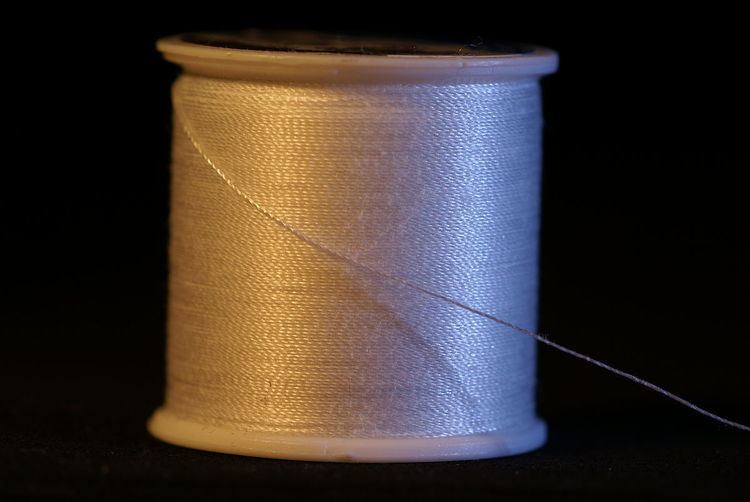 | ||
Thread is a type of yarn used for sewing.
Contents
Materials
Thread is made from a wide variety of materials. The following table lists common materials, a general description and what they are supposed to be good for. If your machine will sew with the thread, any thread can used for just about any purpose. This is very useful for someone who is trying to learn sewing. However, it should be remembered that where a thread is stronger than the material that it is being used to join, if seams are placed under strain the material may tear before the thread breaks. Garments are usually sewn with threads of lesser strength than the fabric so that if stressed the seam will break before the garment. Heavy goods that must withstand considerable stresses such as upholstery, car seating, tarpaulins, tents, and saddlery require very strong threads. Attempting repairs with light weight thread will usually result in rapid failure, though again, using a thread that is stronger than the material being sewn can end up causing rips in that material before the thread itself gives way.
Polyester/polyester core spun thread is made by wrapping staple polyester around a continuous polyester filament during spinning and plying these yarns into a sewing thread. Core Spun Thread
Thread gauges
Yarns are measured by the density of the yarn, which is described by various units of textile measurement relating to a standardized length per weight. These units do not directly correspond to thread diameter.
Wt and Gunze count
The most common weight system specifies the length of the thread in kilometres required to weigh 1 kilogram. Therefore, a greater weight number (indicated in the American standard by the abbreviation wt) indicates a thinner, finer thread. The American standard of thread weight was adopted from the Gunze Count standard of Japan which uses two numbers separated by a forward slash. The first number corresponds to the wt number of the thread and the second number indicates how many strands of fiber were used to compose the finished thread. It is common to wrap three strands of the same weight to make one thread, though this is not a formal requirement in the US standard (which is therefore less informative).
Denier
A denier weight specification states how many grams 9,000 meters of the thread weighs. Unlike the common thread weight system, the greater the denier number, the thicker the thread. The denier weight system, like the common weight system, also specifies the number of strands of the specified weight which were wrapped together to make the finished thread.
Tex
Tex is the mass in grams of 1,000 meters of thread. If 1,000 meters weighs 25 grams, it is a tex 25. Larger tex numbers are heavier threads. Tex is used more commonly in Europe and Canada.
Aughts
Some thread manufacturers, especially those producing very fine silk threads, apply their own scales of thread measurement using "aughts" or zeroes (not unlike the zeros used in measuring the sizes of seed beads). Within a given manufacturer's spectrum, a higher "aught count" indicates a finer thread: this is usually given as a single digit followed by a forward slash and a zero— for example, 3/0 indicates a three-aught thread or a thread size "000", but this number only has significance when compared to other threads produced by the same manufacturer: one manufacturer's 4/0 will always be more fine than that same manufacturer's 2/0, but will mean nothing if compared to the 4/0 of another manufacturer. The aught scale therefore is not suitable for conversion or comparison to other more-generalized weight scales, though it is in common use.
Conversion information
Thread weight conversion table
For example: 40 weight = 225 denier = Tex 25. A common Tex number for general sewing thread is Tex 25 or Tex 30. A slightly heavier silk buttonhole thread suitable for bartacking, small leather items, and decorative seams might be Tex 40. A strong, durable upholstery thread, Tex 75. A heavy duty topstitching thread for coats, bags, and shoes, Tex 100. A very strong topstitching thread suitable for luggage and tarpaulins, Tex 265-Tex 290. But a fine serging thread, only Tex 13. For blindstitching and felling machines, an even finer Tex 8.
High-temperature sewing threads
High temperature sewing threads provide durability and resistance to extreme temperatures. Some threads can be used for applications up to 800 °C (1472 °F). There are a variety of different sewing threads available which have different applications and benefits.
Kevlar-coated stainless steel sewing threads have a high-temperature and flame-resistant steel core combined with Kevlar coating designed to facilitate easier machine sewing. The stainless steel core has a temperature resistance of up to 800 °C (1472 °F) and the Kevlar coating is heat-resistant up to 220 °C (428 °F).
PTFE coated glass sewing threads have an excellent temperature resistance combined with a PTFE coating to provide easier machine sewing. The glass core has a temperature resistance of up to 550 °C (1022 °F) and the PTFE coating is heat-resistant up to 230 °C (446 °F).
Nomex sewing threads are inherently flame-retardant and heat-resistant with a tough protective coating which resists abrasion during the sewing operation. It is temperature resistant up to 370 °C (698 °F).
Bonded nylon sewing threads are tough, coated with abrasion resistance, rot proofing, and have good tensile strength for lower temperature applications. They are temperature-resistant up to 120 °C (248 °F)
Bonded polyester sewing threads are tough, coated with abrasion resistance, rotproofing, and have exceptional tensile strength for lower temperatures but heavier-duty sewing operations. They are temperature-resistant up to 120 °C (248 °F)
